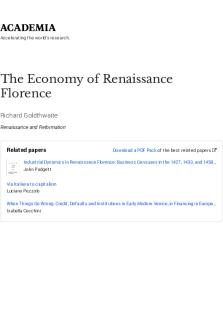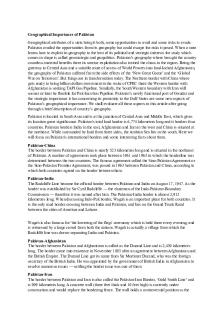Assignmnet 3 - Globalisation of Products for the Growth of Economy of Pakistan PDF

| Title | Assignmnet 3 - Globalisation of Products for the Growth of Economy of Pakistan |
|---|---|
| Course | Pakistan Studies |
| Institution | COMSATS University Islamabad |
| Pages | 19 |
| File Size | 537.6 KB |
| File Type | |
| Total Downloads | 26 |
| Total Views | 128 |
Summary
Globalisation of Products for the Growth of Economy of Pakistan...
Description
Course Title: Pakistan Studies Course Code: HUM111 Submitted by: Amer Murtaza Registration No.: FA18-BSE-125 Submitted to: Muhammad Tanveer Jamal
Globalisation of Products for the Growth of Economy of Pakistan Current Economic, Social and Political Challenges of The Industrial Sector of Pakistan
TABLE OF CONTENTS Introduction-------------------------------------------------------------------------------2 Economic Conditions--------------------------------------------------------------------2 Energy Crisis------------------------------------------------------------------------------3 Political Conditions----------------------------------------------------------------------3 S O CIA L C O ND IT IO NS ----------------------------------------------------------------6 Globalization-----------------------------------------------------------------------------6 Economy of Pakistan--------------------------------------------------------------------9 India----------------------------------------------------------------------------------------9 International Monetary Fund------------------------------------------------------------7 NAFTA------------------------------------------------------------------------------------7 Punjab------------------------------------------------------------------------------------10 Sindh-------------------------------------------------------------------------------------10 South Asia------------------------------------------------------------------------------7, 9 textile sector-----------------------------------------------------------------------------11 Challenges of Globalization-----------------------------------------------------------11 Macroeconomic Stability--------------------------------------------------------------15 Human Development-------------------------------------------------------------------16 Conclusion-------------------------------------------------------------------------------17 Bibliography-----------------------------------------------------------------------------19
The following report deals with the Current Political, Social and Economical issues related with the industrial sector of Pakistan on the whole while it provides an in-depth evaluation of how Globalisation of Products affects the economic structure of the country. Also, included in the report are the main problems, issues and challenges that the country comes across in this regard and some suggested solutions and how they can be implemented. It provides suggestions as to how the government, organisations, business-related personnel, overseas and domestic consumers can help in this regard.
2
3
INTRODUCTION: The following report deals with the Current Political, Social and Economical issues related with the industrial sector of Pakistan on the whole while it provides an in-depth evaluation of how Globalisation of Products affects the economic structure of the country. Also, included in the report are the main problems, issues and challenges that the country comes across in this regard and some suggested solutions and how they can be implemented. It provides suggestions as to how the government, organisations, business-related personnel, overseas and domestic consumers can help in this regard. INDUSTRIAL SECTOR: Pakistan ranked as number 43-44 among the countries of the world in nominal GDP, 26th in GDP with purchasing power parity and number 55 in the world in factory output Pakistan's industrial sector accounts for about 24% of GDP. Cotton textile production and apparel manufacturing are Pakistan's largest industries, accounting for about 66% of the merchandise exports and almost 40% of the employed labour force. Cotton and cotton-based products account for 61% of export earnings of Pakistan. The consumption of cotton increased by 5.7% over the past five years while the economic growth rate was 7%. By 2010 the spinning capacity increased to 15 million spindles and textile exports hit $15.5 billion Other major industries include cement, fertilizer, edible oil, sugar, steel, tobacco, chemicals, machinery and food processing. The government is privatizing large-scale parastatal units, and the public sector accounts for a shrinking proportion of industrial output, while growth in overall industrial output (including the private sector) has accelerated. Government policies aim to diversify the country's industrial base and bolster export industries. PROBLEMS IN THE INDUSTRIAL SECTOR: With a population of 180 million, a geo-strategic location, the required human resources and natural endowments, Pakistan has all the potential to grow as a developed industrial national. Unfortunately, it is still a developing nation even after lapse of more than six decades since it appeared on the world map as a sovereign and independent nation. Having rich in natural resources, the country has been going through major challenges and issues hitting the industrialization include growing power crisis, chronic energy shortage, high interest rate, administrative bottlenecks, bad governance, lack of institutional framework, political wrangling and worsening law and order situation. ECONOMIC CONDITIONS: Pakistan is the 27th largest economy in the world, with a GDP (PPP) of US$ 464.897 billion. It operates on a semi-industrialized economy, which includes agriculture, textiles, mining and IT industries. Since 2000, the Pakistan government under then-President Pevez Musharraf aim to boost the economy of Pakistan by introducing various macroeconomic policies. The government initiative of the privatization of Pakistan's industry and services has boosted job growth opportunities, and are the driving force behind the country's economic growth in the 2000s. Pakistan has large reserve of natural resources, which include oil, coal, iron, ore, copper, salt and gold. Pakistan has the 2nd largest salt mine, 2nd largest coal reservoirs and 5th largest goal mine in the world. However, due to constraints in infrastructure and funding, the exploration and production of the natural reserves has been slow. Experts predict current exploration makes up only about 20 - 30 percent of the country's deposits. Pakistan's Industry Sectors Agriculture was responsible for 21.8 percent of Pakistan's GDP in 2010. Pakistan's arable land, which takes up 25 percent of total land area, makes the country one of the world's largest producers of commodities, which include apricot, buffalo milk, chickpea, cotton, dates, mango, onion, oranges, rice, sugarcane, tangerines and wheat, according to Food and Agriculture Organization. Industry is also important to Pakistan's economy. It contributes 23.6 percent to the nation's total GDP and employs 20.3 percent of the total workforce. Important industries includes textiles, mining and information technology. Pakistan has a sound textile industry, as it is one of the major producers of cotton in the world. Textiles and apparel manufacturing contributes 51.4 percent of the country's total exports. The textile industry also employs 40 percent of the industrial workforce.
4
Information technology (IT) industry in Pakistan has been growing in recent years. This growth can be observed from the increase in software exports to foreign markets. The booming IT industry also sees a rise in the number of IT companies set up in the country. To date, there are 1306 IT companies in the estimated IT market of US$2.8 billion. In 2010, services contributes 54.6 percent of Pakistan's total GDP, and employs 36.6 percent of the workforce. The government's initiative of the privatization of telecommunications, utilities and banking industry have brought about significant job growth opportunities in services. Telecommunications plays an important role in the services of Pakistan. For the mobile phone market alone, the number of subscribers have multiplied exponentially since 2000, to reach over 100 million users, boasting one of the highest mobile densities in the world. Telecommunications is also the most attractive industry in Pakistan for foreign direct investment, amounting to over 9 billion since 2000. Energy crisis Industry has virtually held hostage by the energy crisis. The country faces an energy emergency. Gas load shedding has become a routine in major industrial cities of the country. The officials have projected a gas shortfall of 10.34 billion cubic feet per day by financial year 2015. The country’s demand for energy, according to one estimate, is expected to rise at the rate of 10-12 percent annually in the foreseeable future, which means that if this rate of increase continues, demand for energy may well double before 2015. The acute energy crisis has virtually suffocated the industry, causing widespread discontentment in the business circles. This could result in closure of more industrial units and increase in the unemployment rate in the war-torn country. The country is losing at least 2 percent of the GDP growth annually due to the power shortages. The liabilities to the entire energy chain or circular debt continued to increase in the absence of any plan for power sector reforms. The circular debt has now reached Rs400 billion mark. The circular debt problem emerged due to difference between production cost of electricity and the tariff charged from consumers, which forced the government to provide subsidy. The government failed to bridge the gap in power production costs and the money paid by utility consumers. Higher cost of furnace oil forced the government to raise power tariff, but the consumer tariff is still believed to be less than the cost of power. The expensive power particularly for commercial and industrial sectors will further fuel the inflation pushing more people into extreme poverty in the country. Interest rate Under IMF pressure, the government maintained one of the world’s highest benchmark interest rates, in an economy hurt by terrorism and falling foreign investment. The high interest rate has been one of the major reasons behind the fall in the country’s industrial output. During the five-year tenure of the former government of Pakistan People’s Party (PPP), the real gross domestic product (GDP) growth averaged at 3 percent against the required rate of 7 percent, according to the Economic Survey of Pakistan for the fiscal year 2013-14. The reduction in discount rate to single digit could provide some relief to the ailing industry. Private sector can play a supreme role in the industrialization of the country. The execution of any industrial program depends on investment of foreign capital, coupled with technical skill. The central bank’s tight monetary policy has not allowed the private sector to play its key part as engine of growth. The increased interest rate has not only made doing business increasingly expensive but also marginalized the private sector. High borrowing costs discouraged the demand for private sector credit, which in turn decreased private investment adversely affecting the prospects of economic growth. POLITICAL CONDITIONS: Poor governance The quality of governance is essential for the development of human resources for industrial growth. The good governance ensures the transparency, efficiency and rationality in the utilization of public funds and national resources, encourages growth of the private sector, promotes effective delivery of public services and helps establish the rule of law. There is a strong correlation between per capita income and indicators of human development such as adult literacy, life expectancy, infant mortality, political and civil rights. Ayub’s Era
5
Muhammad Ayub Khan was the first armed ruler of Pakistan, serving as the President of Pakistan. As a result of his having control of the Pakistan Army “Ayub deposed his mentor President Iskander Mirza in a bloodless military coup triggering a succession of military takeover in Pakistan history” (Singh, 2011, 182). Ayoub was really welcomed in Pakistan, since the nation had experienced a very unstable political situation since freedom. This would be the first of many instances in the history of Pakistan of the military becoming directly involved in politics. From 1958 to1968 this was first martial law with an American presidential system and saw the rise of the capitalist class. The 1960s stands out as the decade with best performance, it was Ayoub Khan’s era. In Ayub era first time in Pakistan there were automobile industry, a cement industry and few other heavy modern industries. There was rapid industrial progress (mainly in the western wing of the country) with two five-year economic progress plans in this era. We also came to know that “development decade actually became a decade of exploitation and purposeful support of dissimilarity between classes and regions with the 22 big industrial families amassing most of the wealth. The record reveals that Pakistan's Second Year Plan (19601965), the one that cover a good part of the martial law period, was an extensive success as according to statically point.” (Hassan,1998, 235). As we know Ayoub’s economical policies were dependent on the model of capitalism and followed the Free-market economics main beliefs, industrialization that took place in his period is frequently regarded as “Great Decade” in the history of the country. “The "Great Decade" was celebrated, which highlighted the development plans executed during the years of Ayub's rule, the private association companies, and industries and credited with creating an situation where the private sector was encouraged to start medium and small-scale industries in Pakistan” (Toor, 2011, 84). This thing created new job opportunities and thus the economic graph of the country started growing. Ayub introduced a new curriculum and books for schools. Many schools and colleges were constructed through his era. In this context Siddiqa (2007) introduced farming reforms according to him no one could occupy land less than 12.5 acres in others words maximum 500 acres irrigated land and 1000 unirrigated. An oil processing plant in Karachi was set up, and these reforms led to 15% GNP of the country that was three times greater than that of India. Despite the increase in the GNP the profit and revenue was gained by the 22 families that controlled 66% of the industries and land of the country and 80% of the banking and insurance of Pakistan.
Zia’s era “Takeover by General Zia ul Haq in 1977 had crystallized the hegemony of the civil and military bureaucracy, not just on the political map of Pakistan. With political and administrative roles and interests, the civil and military bureaucracy emerged as a key and well-established entity in the economy” (Singh, 2011, 180). With the takeover by General Zia armed rule returned and the capitalist class was back in power. “Zia also extended the role of the army in governance through extensive utilize of military intelligence, selection of senior officers to key posts and general dispensation of patronage to armed forces” (Hassan, 1998, 236). We also came to know “important economic growth and relatively low price increases during the Zia period did translate into broad based income growth for most income group” (Siddiqa, 2007, 64). We also came to know that economy under Zia enjoyed a high and constant rate of growth. The economy extended to nearly 6.6% per annum and inflation tended to decline during 77-78. There was a broad sharing of the benefits of growth. Real wages improved and poverty tended to decline” (Hassan, 1998, 237). In the Zia’s era the investment climate for the private sector was improved by providing guarantees against future nationalization, clearer demarcations of activities between the public and the private sector and extra tax concessions”(Ahmed, 2014, 47). As regarding to economic development Hassan (1998, 39), very beautifully summarized the economic growth as calculated by GNP slowed down during Zia’s last five years. This is also important that during 197783, the quick rise in worker remittances had pushed GNP growth rate to an annual record of 7.6% per annum. Worker remittances tended to refuse gradually after 1982-3 and interest payments on external debt gathered momentum, the GNP growth rate fell sharply to 4.9% per annum during 1983-8. In the first half of the 1980’s, worker remittances were about as important a source of foreign exchange as products exports. Hassan also described that unluckily, the workers remittances boom did not translate into an extensively higher rate of nationwide savings and investments. Most of the remittances were directed to utilization and this played a main role in falling poverty. The yearly wages of two main wage groups of factory workers point to an increase in nominal wage of around 150% over 1977-88.
6
As regarding to industrial development there were important development “through the Zia period in the industrial plan framework in terms of stress on the role of the private sector, greater import liberalization of industrial raw materials, and relatively increase of incentives for manufactured exports, not much was done to signal basic change in industrial policies which had hampered the structural change in manufacturing during the 1960’s and 1970’s” (Ahmed, 2014, 52). There is also a comprehensive debate on exchange rate and trade policy in a book Pakistan’s Economyat the Crossroads: Past Policiesand Present Imperatives, by Hassan, Pervez (1998), he argued that Pakistan in 1982 began to regularly adjust the value of the rupee The rupee was devalued from Rs. 9.90 per US dollar to Rs. 11.84 in 1982 and then gradually depreciated to Rs. 18 per US dollar by the end 1988. Between 1982 and 1988, there was a substantial real depreciation of the rupee; the nominal exchange rate was devalued almost twice as fast as warranted by the relative change in prices between Pakistan and major trading partners. Hassan also explained that real devaluation assisted the overall export expansion of 7-8% per annum during the period and contributed in a significant way in reducing the relative dependence on worker remittance. By 1988 exports were more than double the level of remittances. The industrial zone was established in the late 1970’s to attract foreign investment, speed up flow of modern technology, provide more job opportunities, raise skill and management standards and provide exporters a base for production in an environment free from import duties but the results were however disappointing as exports from the zone were relatively small. Musharraf’s Era 12 October, 1999 General Pervez Musharraf took control of the country and imposes Martial law Musharraf economic policies keep the economy to grow for a short time period. The Musharraf’s rule proves to be a growing period of economy, where every sector of economy was growing. The military returned to power and government, under General Musharraf in October 1999 where he declared the state of emergency which claimed to be equivalent to the state of Martial Law as the constitution of Pakistan of 1973, was suspended, and the Chief Justices of the Supreme Court were fired. He also issued some amendments in the Military Act, which gave the Armed Forces some additional powers. “The economy experienced high growth from 1999 to 2007 under Musharraf with an average real rate of 7 % for the past five years. But economic issues were almost totally neglected during 2007’s political turmoil. As global prices raised steeply, Pakistan’s mechanism for the automatic adjustment of prices of oil products was dropped. The heavy cost of food and fuel subsidies caused reserves to drop from about $14 billion in November 2008, enough to cover only two months of imports” (Singh, 2011, 86). “Foreign investment has dried up and investors have sought to withdraw their assets. International financial institutions estimate that some $5bn of extra financing is needed immediately if a financial crisis is to be averted, and twice that amount over two years”(Ahmed, 2014, 48). On the economy, Musharraf is more compelling. While running the country, “he and his capable finance minister, Shaukat Aziz, chalked up a number of economic achievements, including tripling government receip...
Similar Free PDFs

Characteristics of globalisation
- 2 Pages

The Science of Bakery Products
- 275 Pages

Drivers of Globalisation
- 14 Pages

The Political Economy of Crisis
- 5 Pages
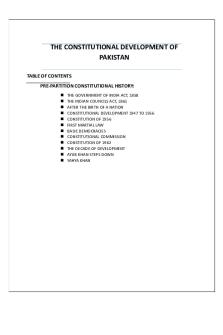
Constitutional History of pakistan
- 16 Pages
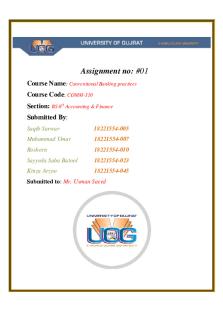
25 Banks of PAKISTAN
- 25 Pages
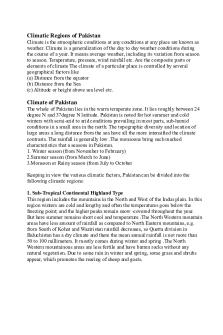
Climatic Regions of Pakistan
- 2 Pages
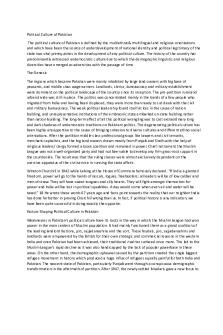
Political culture of Pakistan
- 11 Pages

Types of consumer products
- 21 Pages
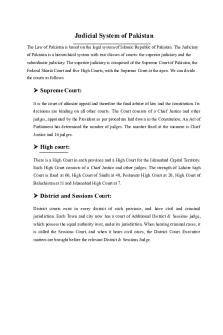
Judicial System of Pakistan
- 2 Pages
Popular Institutions
- Tinajero National High School - Annex
- Politeknik Caltex Riau
- Yokohama City University
- SGT University
- University of Al-Qadisiyah
- Divine Word College of Vigan
- Techniek College Rotterdam
- Universidade de Santiago
- Universiti Teknologi MARA Cawangan Johor Kampus Pasir Gudang
- Poltekkes Kemenkes Yogyakarta
- Baguio City National High School
- Colegio san marcos
- preparatoria uno
- Centro de Bachillerato Tecnológico Industrial y de Servicios No. 107
- Dalian Maritime University
- Quang Trung Secondary School
- Colegio Tecnológico en Informática
- Corporación Regional de Educación Superior
- Grupo CEDVA
- Dar Al Uloom University
- Centro de Estudios Preuniversitarios de la Universidad Nacional de Ingeniería
- 上智大学
- Aakash International School, Nuna Majara
- San Felipe Neri Catholic School
- Kang Chiao International School - New Taipei City
- Misamis Occidental National High School
- Institución Educativa Escuela Normal Juan Ladrilleros
- Kolehiyo ng Pantukan
- Batanes State College
- Instituto Continental
- Sekolah Menengah Kejuruan Kesehatan Kaltara (Tarakan)
- Colegio de La Inmaculada Concepcion - Cebu


